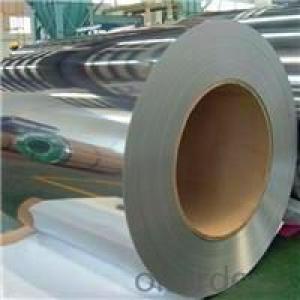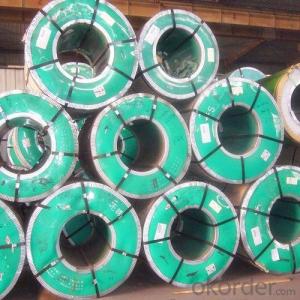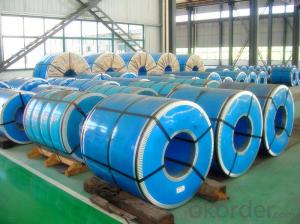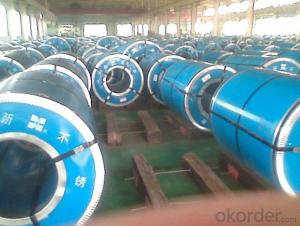Stainless Steel Coil Cold Rolled 304 With Best Quality
- Loading Port:
- China main port
- Payment Terms:
- TT OR LC
- Min Order Qty:
- 100 m.t.
- Supply Capability:
- 5000 m.t./month
OKorder Service Pledge
OKorder Financial Service
You Might Also Like
1.Structure of Stainless Steel Coil Cold Rolled 304 With Good Quality
Cold Rolled stainless steel Coil with good quality is one of the raw material of the cold
rolled stainless steel Coil, which can be used directly in many places. Stainless Steel
(Stainless Steel) is short for acid-proof Stainless Steel, resistant to weak corrosive
medium such as air, steam, water, or with a Stainless Steel grade.
2.Main Features of Prefabricated Steel Structure High Building Project
Weld-ability: The purpose of the different requirement for welding performance are
different.1 Kind of tableware generally do not require the performance of welding, even
including some pot class enterprise. But the vast majority of products all need raw
materials welding performance is good, like the 2 kinds of tableware, thermos flask, steel
pipes, water heaters, water dispensers, etc.
Heat resistant performance Heat resistant performance refers to the high temperature
stainless steel can still maintain its excellent physical and mechanical properties. Carbon:
the influence of carbon in austenitic stainless steel is formed strong and steady. Set the
austenitic austenitic area and expand elements. Carbon formation of austenite is about 30
times that of the nickel, the ability of carbon is a kind of gap elements, through the solid
solution strengthening can significantly increase the strength of the austenitic stainless
steel. Carbon austenitic stainless steel can be improved in high concentration chloride
(e.g., 42% MgCl2 boiling solution) in the performance of the resistance to stress corrosion.
But, in the austenitic stainless steel, carbon is often seen as the harmful elements, this is
mainly due to the corrosion of stainless steel used in some conditions, such as welding or
heating by 450 ~ 850 ℃), carbon steel with chromium in forming high chromium Cr23C6
type carbon compounds which can lead to local chromium depletion, make steel corrosion
resistance especially resistant to intergranular corrosion performance degradation. So.
Since the 60 s of the development of new Cr-Ni austenitic stainless steel is mostly carbon
content less than 0.03% or 0.02% of the ultra-low carbon type.
3. Stainless Steel Coil Cold Rolled 304 With Good Quality Images
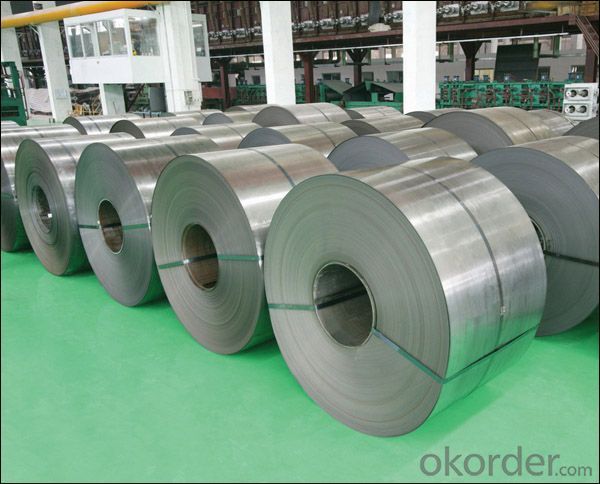
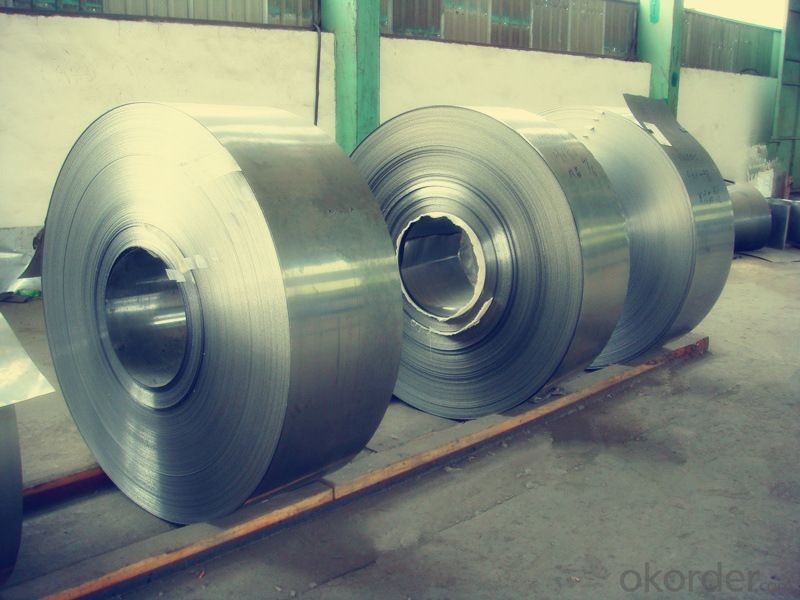
4. Stainless Steel Coil Cold Rolled 304 With Good Quality Specification
Ferritic stainless steel Chromium containing 15% ~ 30%. Its corrosion resistance,
toughness and weldability with chromium content increases with the increase of chloride
stress corrosion resistance is superior to other types of stainless steel, fall into this
category of Crl7, Cr17Mo2Ti, Cr25, Cr25Mo3Ti, Cr28, etc. Ferritic stainless steel because
of the high chromium content, corrosion resistance and oxidation resistance are relatively
good, but the mechanical properties and process performance is poorer, more used to
stress less acid structure and steel used as antioxidant. This kind of steel to withstand
atmosphere, nitric acid and corrosion of the brine solution, and has good high temperature
oxidation resistance, low thermal expansion coefficient, etc, used in nitric acid and food
factory equipment, also can make work under high temperature parts, such as gas turbine
parts, etc.
Austenitic, ferritic duplex stainless steel The advantages of both austenitic and ferritic
stainless steel, and has the superplasticity. Austenite and ferrite The title Each accounts
for about half of the stainless steel. In the case of contain low C, Cr content was 18% ~
18%, Ni content at 3% ~ 3%. Some steel containing Mo, Cu, Si, Nb, Ti, N and other
alloying elements. This kind of steel both austenite and ferrite stainless steel, the
characteristics of compared with ferrite, plasticity and toughness is higher, no room
temperature brittleness, intergranular corrosion resistance and welding performance were
significantly increased, while maintaining a ferritic stainless steel of 475 ℃ brittleness and
high thermal conductivity, has the characteristics of superplasticity. Compared with
austenitic stainless steel, high strength and resistance to intergranular corrosion and
resistance to chloride stress corrosion is improved obviously. Duplex stainless steel has
excellent resistance to pitting corrosion performance, is also a kind of nickel and stainless
steel.
5. Applications of Stainless Steel Coil 304 With Good Quality
1. Kitchenware: tableware, cookware, Stoves…
2. Food packing: storage cans, food containers…
3. Construction: bridge, roofing, wall, decoration, bathroom accessories…
4. Precision instruments: electrical products, aerospace…
5. Others: automotive parts, machine building, chemical processing, farming…
6.FAQ of Stainless Steel Coil 304 With Good Quality
We have organized several common questions for our clients,may help you sincerely:
How to guarantee the quality of the products?
We have established the international advanced quality management system,every link
from raw material to final product we have strict quality test;We resolutely put an end to
unqualified products flowing into the market. At the same time, we willprovide necessary
follow-up service assurance.
How is the packaging and delivery?
Standard export packing (Coil: waterproof paper + protective steel ring; Circle: wooden
box), or as your requirement and the delivery term is based on the project.
- Q:Can 111 stainless steel strips be passivated to enhance corrosion resistance?
- Certainly! Passivation can improve the corrosion resistance of 111 stainless steel strips. It involves removing iron from the surface and creating a protective oxide layer. This layer acts as a barrier, preventing further corrosion and increasing resistance to chemicals, moisture, and temperature. Industries such as automotive, aerospace, medical, and food processing commonly use passivation to enhance the longevity and performance of stainless steel components. Consequently, by passivating the 111 stainless steel strips, their corrosion resistance can be enhanced, resulting in improved durability and reliability for their intended applications.
- Q:What are the recommended guidelines for machining 111 stainless steel strips?
- The recommended guidelines for machining 111 stainless steel strips typically include using a sharp cutting tool, maintaining proper coolant and lubrication, controlling cutting speed and feed rate, and ensuring proper clamping and fixturing to minimize vibrations. Additionally, it is important to monitor and adjust the machining parameters based on the specific grade of the stainless steel and the desired surface finish.
- Q:Are stainless steel strips suitable for architectural applications?
- Yes, stainless steel strips are suitable for architectural applications. Stainless steel is a versatile and durable material that is widely used in the architectural industry for various applications. It offers excellent corrosion resistance, high strength, and an attractive appearance, making it a popular choice for both interior and exterior architectural elements. Stainless steel strips can be used in a wide range of architectural applications, including wall cladding, roofing, facades, handrails, balustrades, columns, and decorative features. They can be easily shaped, bent, and welded to create customized designs, allowing architects and designers to achieve their desired aesthetics. In addition to its aesthetic appeal, stainless steel is a low-maintenance material that is resistant to staining, scratches, and fading. It is also highly durable and can withstand harsh weather conditions, making it suitable for both indoor and outdoor applications. Furthermore, stainless steel strips are available in various finishes, including brushed, polished, and patterned, providing architects and designers with a wide range of options to choose from. This versatility allows for the integration of stainless steel strips into different architectural styles and designs. Overall, stainless steel strips are an excellent choice for architectural applications due to their durability, corrosion resistance, aesthetic appeal, and ease of customization.
- Q:What are the common surface defects in stainless steel strips?
- Common surface defects in stainless steel strips include scratches, pits, roll marks, and scale.
- Q:What is the thermal conductivity of stainless steel strips?
- The thermal conductivity of stainless steel strips is typically around 16-24 W/m·K, depending on the specific grade and composition of the stainless steel.
- Q:What are the common uses of stainless steel strips in the aerospace industry?
- Due to their exceptional properties and characteristics, stainless steel strips find numerous applications in the aerospace industry. Fabricating aircraft components is one of their primary uses. These strips are crucial in producing structural parts like wing spars, fuselage frames, and landing gear components. The outstanding strength and corrosion resistance of stainless steel make it the perfect material for these critical components. It guarantees the aircraft's structural integrity and longevity. Aerospace manufacturers often prefer stainless steel strips over other materials due to their ability to endure extreme temperatures and pressures encountered during flight. Another significant application of stainless steel strips in the aerospace industry involves exhaust systems. These strips are essential in constructing exhaust pipes, mufflers, and heat shields. Thanks to stainless steel's heat resistance properties, it can withstand the high temperatures generated by aircraft engines while maintaining its structural integrity. Furthermore, stainless steel strips are employed in fabricating fuel tanks and hydraulic systems for aircraft. The corrosion resistance of stainless steel guarantees the protection and longevity of these vital components, preventing leaks and failures. Moreover, stainless steel strips are utilized in aerospace fastener manufacturing. They are instrumental in creating a range of screws, bolts, and rivets that hold aircraft components together. The high tensile strength and durability of stainless steel make it the ideal material for these fasteners, ensuring the aircraft's structural stability and safety. In conclusion, stainless steel strips play a crucial role in the aerospace industry due to their outstanding properties. They are widely used in fabricating structural components, exhaust systems, fuel tanks, hydraulic systems, and fasteners. The high strength, corrosion resistance, and heat resistance of stainless steel make it an indispensable material for guaranteeing the safety, reliability, and performance of aircraft.
- Q:Can stainless steel strips be easily welded?
- Yes, stainless steel strips can be easily welded. Stainless steel is known for its excellent weldability due to its high melting point, low thermal conductivity, and good heat resistance. The most commonly used welding methods for stainless steel strips include TIG (Tungsten Inert Gas) welding and MIG (Metal Inert Gas) welding. These methods allow for precise control of the welding process and produce strong and durable welds. Additionally, stainless steel strips are often used in various industries, including automotive, construction, and manufacturing, where welding is a common joining technique.
- Q:What are the different grades of stainless steel used for strips?
- Different grades of stainless steel are utilized for strips, each possessing distinct properties and uses. Some commonly used grades include: 1. Austenitic stainless steel (e.g., 304, 316): This type is extensively employed for strips due to its exceptional corrosion resistance, high strength, and good formability. It finds applications in food processing equipment, kitchen appliances, and architectural projects. 2. Ferritic stainless steel (e.g., 430): Known for its magnetic properties and strong resistance to corrosion, especially in acidic environments. It is commonly utilized in automotive trim, kitchen utensils, and decorative strips. 3. Martensitic stainless steel (e.g., 410, 420): Recognized for its high strength, hardness, and resistance to wear. It is commonly used in cutlery, surgical instruments, and industrial applications that require hardness and corrosion resistance. 4. Duplex stainless steel (e.g., 2205): Offers a combination of high strength and resistance to corrosion. It is commonly used in chemical processing equipment, oil and gas pipelines, and marine applications. The grade selection depends on the specific application and desired properties, such as corrosion resistance, strength, formability, and magnetic properties.
- Q:Are stainless steel strips suitable for outdoor applications?
- Yes, stainless steel strips are suitable for outdoor applications. Stainless steel is highly resistant to corrosion, making it ideal for use in outdoor environments where it may be exposed to moisture, sunlight, and other weather conditions. Additionally, stainless steel has a high strength-to-weight ratio and excellent durability, ensuring long-lasting performance even in harsh outdoor settings.
- Q:Can stainless steel strips be used for heat exchanger plates?
- Yes, stainless steel strips can be used for heat exchanger plates. Stainless steel is a highly durable and corrosion-resistant material, making it suitable for use in heat exchangers. The strips can be easily formed into plates of various shapes and sizes, providing flexibility in design and installation. Additionally, stainless steel has excellent thermal conductivity, ensuring efficient heat transfer between fluids. Overall, stainless steel strips are a popular choice for heat exchanger plates due to their strength, resistance to corrosion, and thermal conductivity properties.
1. Manufacturer Overview |
|
|---|---|
| Location | |
| Year Established | |
| Annual Output Value | |
| Main Markets | |
| Company Certifications | |
2. Manufacturer Certificates |
|
|---|---|
| a) Certification Name | |
| Range | |
| Reference | |
| Validity Period | |
3. Manufacturer Capability |
|
|---|---|
| a)Trade Capacity | |
| Nearest Port | |
| Export Percentage | |
| No.of Employees in Trade Department | |
| Language Spoken: | |
| b)Factory Information | |
| Factory Size: | |
| No. of Production Lines | |
| Contract Manufacturing | |
| Product Price Range | |
Send your message to us
Stainless Steel Coil Cold Rolled 304 With Best Quality
- Loading Port:
- China main port
- Payment Terms:
- TT OR LC
- Min Order Qty:
- 100 m.t.
- Supply Capability:
- 5000 m.t./month
OKorder Service Pledge
OKorder Financial Service
Similar products
New products
Hot products
Hot Searches
Related keywords

